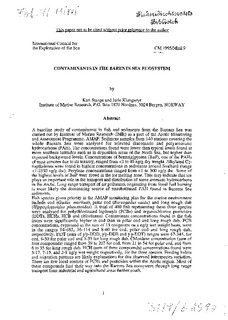| dc.description.abstract | A baseline study of contaminants in fish and sediments from the Barents Sea was
carried out by Institute of Marine Research (IMR) as a part of the Arctic Monitoring
and Assessment Programme, AMAP. Sediment samples from 140 stations covering the
whole Barents Sea were analysed for selected diaromatic and polyaromatic
hydrocarbons (P AH). The concentrations found were lower than typical levels found at
more southern latitudes such as in deposition areas of the North Sea, but higher than
expected background levels. Concentrations of benzo[a]pyrene (BaP), one of the PAHs
of most concern due to its toxicity, ranged from <1 to 40 ng/g dry weight. Alkylated C2-
napthalenes were found in highest concentrations in sediments around Svalbard (range
<1-2330 ng/g dw). Perylene concentrations ranged from <1 to 300 ng/g dw. Same of
the highest levels of BaP were found in the ice melting zone. This may indicate that ice
plays an important role in the transport and distribution of same aromatic hydrocarbons
in the Arctic. Long range transport of air pollutants originating from fossil fuel burning
is most likely the dominating source of unsubstituted PAH found in Barents Sea
sediments.
Fish species given priority in the AMAP monitoring plan for the marine environment
include cod (Gadus morhua), polar cod (Boreogadus saida) and lang rough dab
(Hippoglossoides platessoides). A total of 400 fish representing these three species
were analysed for polychlorinated biphenyls (PCBs) and organochlorine pesticides
(DDTs, HCHs, HCB and chlordanes). Contaminant concentrations found in the fish
livers were significantly higher in cod than in polar cod and lang rough dab. PCB
concentrations, expressed as the sum of 13 congeners on a ng/g wet weight basis, were
in the ranges 94-685, 36-114 and 8-60 for cod, polar cod and lang rough dab,
respectively. DDT (sum of p'p-DDD, p'p-DDE and p'p-DDT) ranges were 67-344, for
cod, 8-50 for polar cod and 5-33 for lang rough dab. Chlordane concentration (sum of
four compounds) ranged from 39 to 207 for cod, from 21 to 54 for polar cod, and from
6 to 35 for lang rough dab. HCH (sum of three compounds) concentrations found were
3-17, 7-15, and 2-8 ng/ g wet weight respectively, for the three species. Feeding habits
and migration patterns are likely explanations for this observed interspecies variation.
There are few local sources of PCBs and pesticides within the Arctic region. Most of
these compounds find their way into the Barents Sea ecosystem through lang range
transport from industrial and agricultural areas further south. | no_NO |
